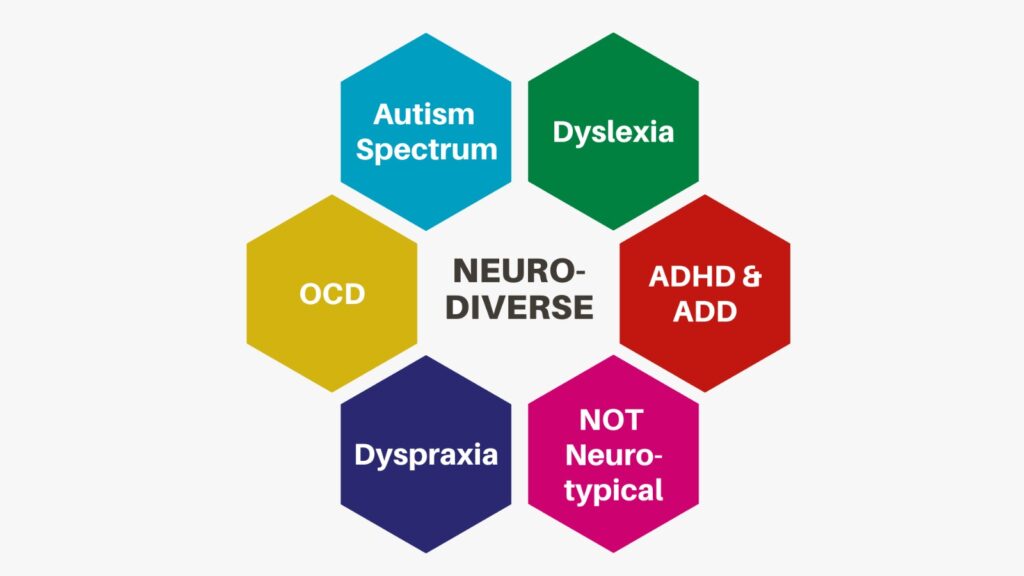Why would an initiative designed to support neurodivergent employees end up failing some of them? Such initiatives can fail miserably … or they can be successful beyond our expectations!

There’s been much research about the competitive advantage of diversity in regards to race, ethnicity, gender, sexual orientation, and socio-economic status. Diversity among our brains is another kind of diversity. It includes people in the autism spectrum, people who are gifted, and people who experience ADHD, dyslexia, OCD or other cognitive differences.
The interest in building capacity for neurodiversity in the workplace is based on evidence that neurodiversity also gives companies a competitive advantage. That’s true, but only when done right. It could also be a complete failure that leaves damaging fallout, the human kind, in its wake.
When I asked Gord Sherwood, founder of The H.I. (Human Intelligence) Factor, for a solution, he explained, “That’s a big question. With a lot of big answers.”
Clearly, this article can’t possibly address all that is needed to create an environment that nurtures success for neurodiversity in the workplace. However, it can put forth some simple strategies that will make a difference.
Sherwood affirms, “Is it complex? Of course. Can it be successfully accomplished? Absolutely!” He continues, “First, the people leading the programs need to understand how to lay the groundwork and how to know when the organization is ready to move forward. As the programs advance, they need to understand the dynamics at play. They need to be able to anticipate misalignments and know how to turn them into opportunities. Often exceptionally good ones.”
A Long Time Ago in a Land Far Away, This Happened…

My former school district, with all the best intentions, implemented an initiative to include students with learning disabilities in general education classrooms. The move was met with anger, frustration and resistance. Why?
The groundwork for the initiative was not done ahead of time. Teachers weren’t prepared for the change. The initiative was forced upon us. We didn’t understand how inclusion in classes deemed “too hard” for these students benefited them. Worse, that their inclusion didn’t hurt the other students but rather benefited them, was not known. Because the internet wasn’t available yet, we couldn’t go online to learn more about it. We were feeling our way along blindly.
The reality is this is often how diversity initiatives are brought into our organizations. The idea is brought to the table and is developed into an initiative. Then, somewhere between conception and implementation, the process for hiring and supporting a diverse workforce fails.
Fortunately, in my story, because of the determination, persistence, and dedication of the people assigned the challenge, our initiative was overwhelmingly successful. From that experience, I learned much about how to move forward with neurodiversity initiatives.
Good Intentions With No Groundwork Leads to Failure
I’m passionate about neurodiversity in the workplace. Creating processes that make it easier to hire, train and develop people who are divergent thinkers can be a win-win for the company and for the divergent thinker.

Recently, I was able to take my message about neurodiversity to a corporate audience interested in including divergent thinkers on their teams. I followed up my talk with an article, “What is Neurodiversity in the Workplace (and Why Do I Need to Know?)” I was thrilled when the article was shared on LinkedIn, where a robust discussion took place in the comments. That discussion included comments from a neurodivergent person who did not have a good experience in one of these programs. He was clearly angry and hurt. His experience was validated by others who identified as neurodivergent and shared similar concerns.
Their comments revealed that not all is rosy in the neurodiversity movement, which gave me pause. I needed to read these comments. I needed to understand the writers’ pain. I needed to give voice to their experience and concerns. If you have read this far, you are reading my response.
I’m not in the spectrum, so I can’t emotionally understand what someone in the spectrum experiences in the workplace. So, to read comments from someone who is neurodivergent who had a bad experience in a program that was developed specifically for them, that had a focus for employing people in the spectrum, reminded me that we need to proceed with caution. If we’re going to do this work, we need to do it right. We need to proceed thoughtfully and with sensitivity. We need to leave our ego behind and listen to divergent thinkers’ concerns.
Finding New Ways to Include All Employees
When we include people in our workplace who cognitively process information in a different way, the benefit to the company and to co-workers can be immense if implemented thoughtfully. What do we need to consider to ensure that all parties reap the benefits of the initiative? Some of the concerns I’ve gleaned through reader comments and conversations with neurodivergent thinkers are:
- Hiring neurodivergent people is great, but not developing the right environment for us to succeed sets us up for failure before we can even showcase our strengths.
- At recruitment, accommodation or support is often poor. Not out of desire, but often because staff have few reference points. There are often few sources for guidance beyond rigid standard policies.
- Once employed, there’s often a gap in support. It’s usually up to the individual to drive. How many feel comfortable doing that when they join an organization?”
- Please don’t try to put us in a box with a label. It feels patronizing to some of us. Celebrate our divergent thinking without labeling our giftedness. Companies need to avoid the pitfalls of labeling and categorizing people because that is not the intent of increasing neurodiversity in the workplace.
Responding to These Concerns
As I said, this article can’t possibly address all that is needed to create an environment that nurtures success for neurodiversity in the workplace. However, it can put forth some simple strategies that can make a difference.
- New ways of communicating with each other can be promoted. Employees can become more aware of how they speak to or email each other. Managers can approach employees from a more empathetic standpoint and discard the old “my way or the highway” attitude that practically defined the corporate workplace just a couple of decades ago.
- We need to make a cultural shift in our workplace. As we move forward with neurodiversity, employees and managers must be given the opportunity and training that causes a shift in their perspective. That shift can’t be forced. It must come from the lens that there is much to be gained, personally and professionally, from embracing neurodiverse teams in the workplace.
- We need to create a work space that is psychologically safe for neurodivergent employees. In fact, all employees will be more effective when the workplace culture fosters safety: safety for the open expression of ideas, for differences in work styles, for different learning and communication preferences, and for diversity.
Research shows that neurodivergent employees can help boost profits because their contribution increases the opportunity to discover better solutions. There’s so much to be gained. However, if we don’t do the groundwork first, the initiative may fail. It may turn into a poor experience for the team, and worse, a bad experience for the neurodivergent employee.
The repercussions of this failed initiative can be devastating because divergent thinkers have often experienced years of unemployment, underemployment, being let go from a company, or not even getting in the door because they don’t interview well. Their confidence levels may not be very high to begin with and to have a bad experience on top of that can have a tremendously detrimental effect.
To Support Neurodivergent Candidates, Start Small
While there is no best way to implement neurodiverse hiring practices, enough major companies have put programs in place that we have some guidelines and results to look at and follow.
The most pertinent advice? Take baby steps, especially at the beginning.
You’re laying the groundwork for a new way of hiring, of organizing teams, and of managing people. So, you need to get everyone involved on board. There needs to be opportunities for participation, for feedback from managers and team members. There should be analysis. Think through the process.
We need to do more than just throw a group of people together onto a team and say, “Hey, make it work.”
A neurodiversity hiring initiative is so complex, and so important. If it fails, the company may never want to try it again. And that would lock your company away from potential innovators and opportunities for growth.
Have You Ever Planted a Garden?
Companies must look at implementing a neurodiversity program in the same way a gardener would look at creating a new garden on untilled land.
If we don’t put the right fertilizer in the soil, if we don’t till the ground first, if we don’t do the work to get the soil right for the seeds to grow, they probably won’t grow. They’ll die.
It’s the same concept when we are bringing initiatives into our companies. And when an initiative involves making changes at a team level, it can be laden with emotion. The idea will get pushback because people have strong feelings about things that they don’t understand.
“You have to prepare the soil first.”
And once those seeds are planted, you can’t just walk away and expect them to grow. They need water, sunlight, and fertilizer in the right amounts. The gardener must watch those plants grow and make adjustments to the environment to optimize that growth. Without regular monitoring and care, those plants would wither and die.
Definitions as Referenced in this Article:
The following definitions were created by Nick Walker, of neurocosmopolitanism.com.
Neurodiversity is the diversity of human minds, the infinite variation in neurocognitive functioning within our species.
Neurodivergent, sometimes abbreviated as ND, means having a brain that functions in ways that diverge significantly from the dominant societal standards of “normal.”
Neurotypical, often abbreviated as NT, means having a style of neurocognitive functioning that falls within the dominant societal standards of “normal.”
Neurominority, any group, such as people with autism*, which differs from the majority of a population in terms of behavioral traits and brain function
*preferred language … such as autistic people, which…
References:
Dias, J., & Altman, D. (2020, December 1). Psychological safety: an overlooked secret to organizational performance. Retrieved February 7, 2021, from https://www.chieflearningofficer.com/2020/12/01/psychological-safety-an-overlooked-secret-to-organizational-performance/?utm_source=ActiveCampaign&utm_medium=email&utm_content=Child+Care+Isn+t+the+Only+Caregiving+Crisis+Affecting+Women+in+the+Workforce&utm_campaign=CIR_TM_TM+Weekly_011121&vgo_ee=s4q7bRd6TToZi0%2BuTKKoI4YYrEQCx9MwF%2Fra7Q6l2HE%3D
Fitzell, S. A. (2021, January 26). What Is Neurodiversity in the Workplace? | The Learning Strategist IQ. Retrieved February 7, 2021, from https://medium.com/the-learning-strategist-iq/what-is-neurodiversity-in-the-workplace-and-why-do-i-need-to-know-95dfac06cb02
Fostering neurodiversity in teams | Nesta. (n.d.). Retrieved February 7, 2021, from https://www.nesta.org.uk/feature/innovation-squared/fostering-neurodiversity-teams/
Meehan, L. (2020). What is Neurodiversity and How does it Benefit Business · CPL. Retrieved February 7, 2021, from https://www.cpl.com/blog/2020/05/what-is-neurodiversity-and-how-does-it-benefit-business
Neurodiversity at work | Acas. (n.d.). Retrieved February 7, 2021, from https://archive.acas.org.uk/index.aspx?articleid=5858
Neurodiversity Hiring Initiatives & Partnerships. (n.d.). Retrieved February 7, 2021, from https://askearn.org/topics/neurodiversity-in-the-workplace/neurodiversity-hiring-initiatives-partnerships/
Sherwood, G. (n.d.). Cultivating Uncommon Human Intelligence — Engaging Exceptional Minds. Retrieved February 7, 2021, from https://gordsherwood.ca/
Smith, T. (2021). Why Hiring Upside Down Thinkers Is a Competitive Advantage. Retrieved February 7, 2021, from https://www.additudemag.com/workplace-neurodiversity-benefits-adhd-talent/
Woo, E. (2019, October 25). Workplace Neurodiversity | Autism at Work | SAP News Center. Retrieved February 7, 2021, from https://news.sap.com/2019/10/workplace-neurodiversity-autism-at-work-program/

